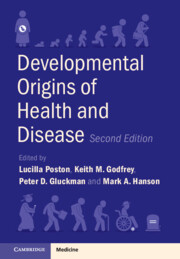Book contents
- Developmental Origins of Health and Disease
- Developmental Origins of Health and Disease
- Copyright page
- Contents
- Contributors
- Preface
- Section I Overview
- Section II Exposures Driving Long-Term DOHaD Effects
- Section III Outcomes
- Chapter 10 Cardiometabolic and Renal DOHaD Outcomes in Offspring of Complicated Pregnancy
- Chapter 11 Developmental Origins of Chronic Respiratory Diseases
- Chapter 12 Early Life Adversity and Female Reproductive Outcomes
- Chapter 13 Developmental Programming of Ageing Induced by Poor Maternal Nutrition
- Section IV Mechanisms
- Section V Interventions
- Section VI Public Health and Policy Implications of Interventions
- Index
- References
Chapter 12 - Early Life Adversity and Female Reproductive Outcomes
How Growth, Diet, and Nutrition Impact Reproductive Function and Accelerated Reproductive Ageing
from Section III - Outcomes
Published online by Cambridge University Press: 01 December 2022
- Developmental Origins of Health and Disease
- Developmental Origins of Health and Disease
- Copyright page
- Contents
- Contributors
- Preface
- Section I Overview
- Section II Exposures Driving Long-Term DOHaD Effects
- Section III Outcomes
- Chapter 10 Cardiometabolic and Renal DOHaD Outcomes in Offspring of Complicated Pregnancy
- Chapter 11 Developmental Origins of Chronic Respiratory Diseases
- Chapter 12 Early Life Adversity and Female Reproductive Outcomes
- Chapter 13 Developmental Programming of Ageing Induced by Poor Maternal Nutrition
- Section IV Mechanisms
- Section V Interventions
- Section VI Public Health and Policy Implications of Interventions
- Index
- References
Summary
Despite concerted efforts to live healthy, active lives, there is significant variability in the ageing process; some individuals live long lives without severe illness, while others develop chronic diseases, become frail and die early. Although the majority of research has concentrated on age-related chronic illnesses, including metabolic and cognitive decline, one undervalued aspect of ageing is reproductive decline and associated morbidities, particularly in women. Early life stress is one of the major factors thought to regulate good or poor ageing, and also when we start to age. In women, early life adversity has been associated with early onset puberty, with impairment of central ovarian regulation, and altered ovarian follicle growth and maturation that may lead to ovarian pathology or premature follicular loss. Although we have some insight into mechanism, molecular pathways remain unclear and we look to future research to define these pathways to guide therapeutic interventions.
- Type
- Chapter
- Information
- Developmental Origins of Health and Disease , pp. 111 - 120Publisher: Cambridge University PressPrint publication year: 2022



